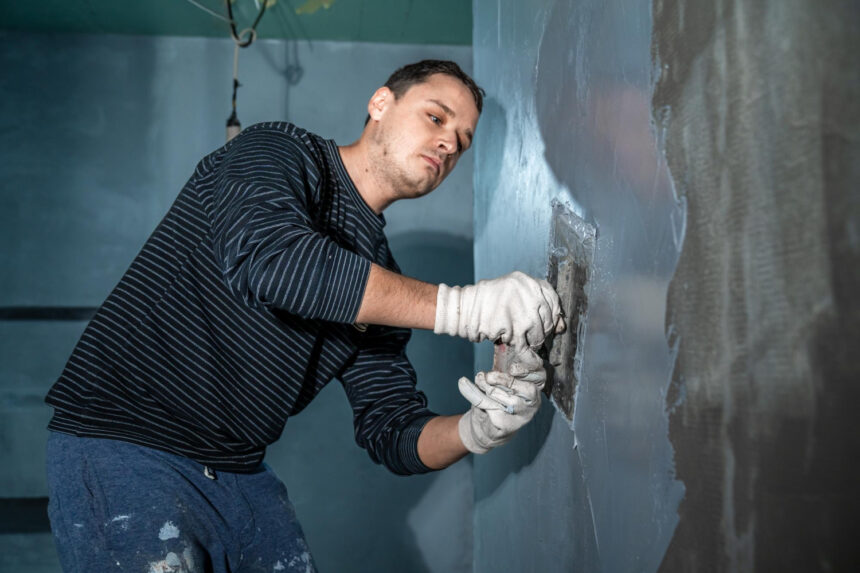Damp proof paint is an important solution for homeowners seeking to protect their interiors from moisture-related issues. This type of paint effectively blocks water and prevents mold, making it essential for maintaining a healthy indoor environment. Understanding how to use and apply damp proof paint can save time and money while enhancing the comfort of a home.
The application process may seem daunting, but it is straightforward when the right steps are followed. Selecting the appropriate product and ensuring that the underlying causes of dampness are addressed can lead to long-lasting results. With the right techniques and products, any homeowner can take control of moisture in their living spaces.
When faced with challenges during the application or maintenance of damp proof paint, knowing the solutions can help. By tackling these common issues, they can ensure that their efforts lead to a successful protect against damp.
Key Takeaways
- Damp proof paint prevents moisture and mold in homes.
- Proper application techniques are key to effectiveness.
- Understanding common challenges can lead to better results.
Understanding Damp Proof Paint
Damp proof paint protects surfaces from moisture. It is important to know the types available, how they work, and the benefits of using them.
Types of Damp Proof Paint
Damp proof paint comes in several types, each formulated for specific needs.
- Latex-Based Paint: This type is common for interior walls. It allows walls to breathe while blocking moisture.
- Acrylic Paint: This is suitable for both interior and exterior surfaces. It has good adhesion and flexibility, handling slight movement in the building.
- Epoxy Paint: Often used in areas exposed to heavy moisture like basements. It forms a strong barrier against water and is highly durable.
Choosing the right type depends on the surface and the moisture level expected in that area.
How Damp Proof Paint Works
Damp proof paint creates a protective layer on surfaces. This layer seals the material, preventing moisture from penetrating.
When applied, the paint forms a barrier that keeps water out.
- The water-resistant ingredients help stop moisture intrusion.
- It also allows some vapors to escape, preventing damage to walls.
This balance is crucial since too much sealing can trap moisture inside, leading to mold issues. Ensuring proper ventilation is key when using damp proof paint.
Benefits of Using Damp Proof Paint
Using damp proof paint offers several advantages.
- Protects Against Damage: It prevents mold growth, peeling paint, and structural damage caused by dampness.
- Increases Lifespan of Surfaces: Surfaces last longer when protected from moisture.
- Versatile Application: It can be applied to various materials like brick, concrete, and stone.
Homeowners find that applying this type of paint saves them money over time by reducing repairs and maintenance costs.
Application of Damp Proof Paint
Applying damp proof paint requires careful attention to surface preparation, correct techniques for application, and understanding the curing process. Each of these factors plays a crucial role in ensuring effective moisture protection.
Surface Preparation
Before applying damp proof paint, it is essential to prepare the surface properly. The area must be clean and free from any old paint, coatings, and debris. Cleaning can include scrubbing with a detergent solution or using a mould wash to remove mould and fungi.
Next, inspect the surface for cracks or holes. Any gaps should be filled with a suitable filler to create a smooth surface. It is crucial to let the filler dry completely before moving on to painting. This preparation helps the paint adhere better and ensures long-lasting protection.
Application Techniques
When applying damp proof paint, use a high-quality brush or roller for even coverage. Start at one corner and work your way across the wall, using long, even strokes. It is important to maintain a wet edge to avoid visible lap marks.
For best results, apply at least two coats of paint. Allow sufficient drying time between coats. The thickness of the application should match the product instructions, as applying it too thick can lead to peeling. It’s also essential to check the weather conditions, as paint should not be applied in extreme humidity or cold.
Curing and Drying Times
Curing times for damp proof paint can vary based on environmental conditions and the product used. Generally, it takes about 24 hours for the paint to dry to the touch, but it may take several days to fully cure.
During the curing phase, protect the surface from moisture and extreme temperatures. Avoid cleaning or applying any topcoat until the product is fully cured. To ensure optimal performance, always refer to the manufacturer’s guidelines regarding drying and curing times.
Common Challenges and Solutions
Damp proof paint can help protect buildings, but several challenges may arise during its application and use. Understanding these common issues and their solutions can lead to better results and longer-lasting protection.
Dealing With High Moisture Areas
High moisture areas, such as bathrooms and basements, can be tough for any paint, including damp proof options. In these locations, moisture levels can exceed the paint’s ability to repel water.
To address this problem, consider these steps:
- Ventilation: Ensure proper airflow to reduce humidity levels.
- Pre-treatment: Apply a moisture-resistant primer before using damp proof paint.
- Dehumidification: Use dehumidifiers to keep moisture levels low.
These measures can improve the performance and durability of damp proof paint in moisture-heavy areas.
Preventing and Treating Mold Growth
Mold can be a significant concern in damp areas. It thrives in moisture and can compromise the integrity of any paint. Addressing mold growth requires proactive measures.
Key strategies include:
- Surface Preparation: Clean surfaces thoroughly to remove any existing mold before painting. Use a mixture of water and detergent or a mold-killing solution.
- Regular Inspections: Check painted areas regularly for signs of mold. Immediate action can prevent more extensive damage.
- Paint Selection: Use mold-resistant damp proof paint to provide an additional layer of protection.
By implementing these strategies, mold growth can be minimized or eliminated.
Adherence Issues on Various Surfaces
Damp proof paint may struggle to adhere well to different types of surfaces. This can lead to peeling or flaking paint over time. Understanding the surface is crucial for a successful application.
To ensure good adherence:
- Surface Preparation: Clean surfaces thoroughly. Remove dust, dirt, and old paint.
- Right Products: Choose a damp proof paint specifically designed for the surface type, whether it’s concrete, brick, or drywall.
- Testing: Conduct a small test on the surface to gauge adhesion before full application.
These steps allow for better bonding and enhance the paint’s effectiveness in protecting against dampness.






